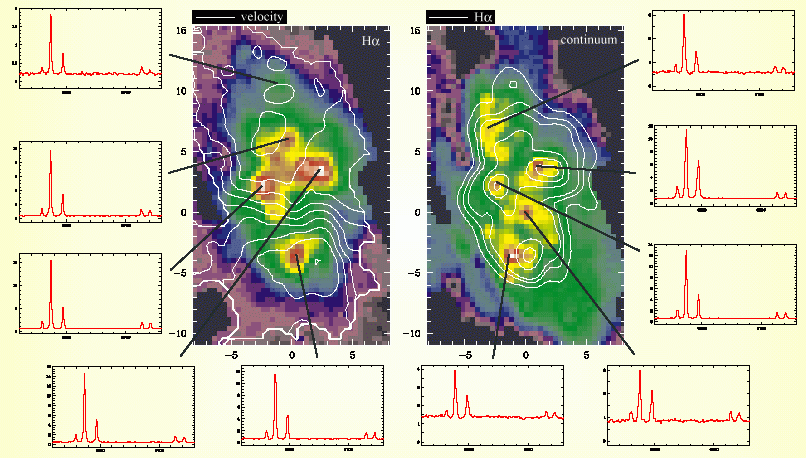Roughly speaking there are as many galaxies in the Universe as there
are stars in our Galaxies, something like 100 billions... Galaxies can
have various
shapes, from elliptical to spiral. Among the great family of spiral
galaxies, about two third have a central stellar bar. These bars, first
identified more than 100 years ago by astronomers visually observing
"nebulae" with the largest telescopes available, play an important
role in the evolution of galaxies. Bars are complex systems and thanks
to new observations and sophisticated numerical models developed in
the last 20 years, considerable progress has been made in
understanding their morphology, dynamics, formation and
evolution. Bars are, of course, principally formed from stars but some
of them have also large amounts of interstellar dust, neutral
hydrogen, ionized and cold molecular gas. They have also different
morphological properties (e.g. amplitude, length, global shape). Our
own Galaxy, the Milky Way, has a small bar in its center.
Bars affect galaxy evolution. Introducing a bar in a spiral disk, for
instance from an interaction with another galaxy, will result in some
dramatic changes for the host galaxy. When the bar is formed, motions
of a large fraction of the stars in the galaxy become chaotic. For the
interstellar gas clouds, these chaotic motions are also
induced. Collisions between the clouds in the system disk become
frequent and violent. Models show that the clouds then start moving
all over the galaxy disk: there is a radial redistribution of the
gas. In particular, a large quantity of gas will fall along the bar
and might eventually reach the galaxy center. This is why it is
believe that bars could be an important factor in feeding up massive
black holes with interstellar material in the center of numerous
galaxies. However, to better understand if this mechanism is plausible
or not, it is necessary to study what happens to the gas falling along
the bar toward the central region.
This week's image shows the central region of NGC 2903, a strong
barred spiral galaxy observed by a team of astronomers using the CFHT
and the integral field spectrograph OASIS.
NGC 2903 is among a larger sample of barred spirals observed with OASIS
to study star formation mechanisms in their bars. The red "spots" seen
in the left image are mostly all regions of massive star formation,
that is, clusters of stars formed from the gas clouds that were
accumulated near the galaxy center after falling along the strong bar.
OASIS allows the astronomers to derive the characteristics of
these star forming regions from spectroscopy. Some example of these
spectra are shown in the small red plots. From these spectral lines,
physical proprieties like the density, the rate of star formation, the
abundance, and the velocity (superimposed in white contours) of these
regions can be studied. As shown here, OASIS has been used to study
about 20 fields all along the bar of NGC 2903 allowing the astronomers
to evaluate how these proprieties are changing according to the position
within the bar. Each field of OASIS contains about 1200 spectra so in
total, more than 20000 spectra were
obtained on NGC 2903!!
Technical description:
These observations have been obtained in February 2000 at CFHT with
OASIS, an integral field spectrograph built by Lyon Observatory. It is
made of an array of 1200 micro-lenses, each of about 1.2 mm
in diameter, located in front of a normal spectrographic stage.
Each lens produces a small image of a portion of the field observed
and a grism spreads the light for each image. Thus, 1200 spectra
are observed at once on one CCD frame! When attached to the adaptive
optics bonnette at CFHT, which corrects for the atmospheric
turbulence, the instrument is used to obtain very precise
spectroscopic information on small sources. OASIS is an unique
instrument with capabilities still unsurpassed to study in great
detail the central regions of galaxies...




